Top speed 473 km/h Wingspan 15 m Introduced 11 November 1943 | Range 1,900 km Length 11 m Weight 4,588 kg | |
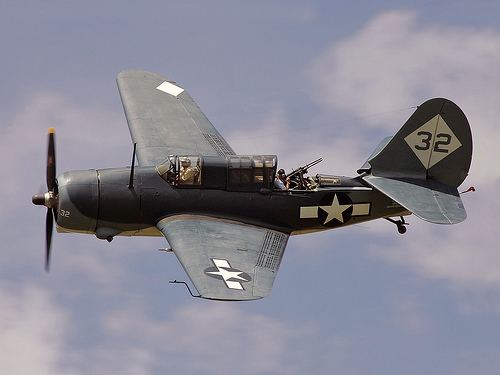 | ||
Engine type Wright R-2600 Twin Cyclone | ||
The world s only flying curtiss sb2c helldiver at tico warbird airshow 2014
The Curtiss SB2C Helldiver was a carrier-based dive bomber aircraft produced for the United States Navy during World War II. It replaced the Douglas SBD Dauntless in US Navy service. The SB2C was much faster than the SBD it replaced.
Contents
- The world s only flying curtiss sb2c helldiver at tico warbird airshow 2014
- Design and development
- US Navy
- Army service
- British service
- Greek service
- French service
- Variants
- Operators
- Greece
- Thailand
- United States
- Specifications SB2C 4 Helldiver
- References

Crew nicknames for the aircraft included the Big-Tailed Beast (or just the derogatory Beast), Two-Cee and Son-of-a-Bitch 2nd Class (after its designation and partly because of its reputation for having difficult handling characteristics). Neither pilots nor aircraft carrier captains seemed to like it.
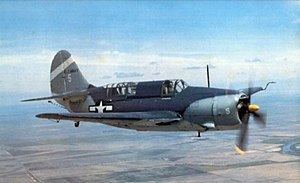
Delays marred its production—by the time the A-25 Shrike variant for the USAAF was deployed in late 1943, the Army Air Forces no longer had a need for a thoroughbred dive bomber. Poor handling of the aircraft was another factor that hampered its service introductions; both the British Royal Navy and the Royal Australian Air Force cancelled substantial orders.
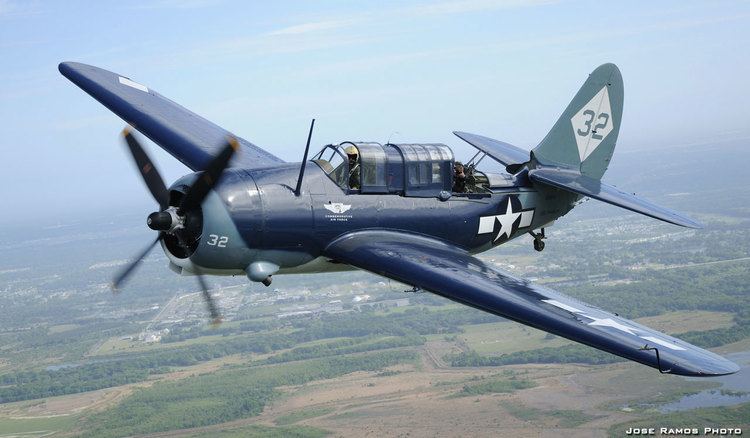
The Truman Committee investigated Helldiver production and turned in a scathing report, which eventually led to the beginning of the end for Curtiss. Problems with the Helldiver were eventually ironed out, and in spite of its early problems, the aircraft was flown through the last two years of the Pacific War with a fine combat record.
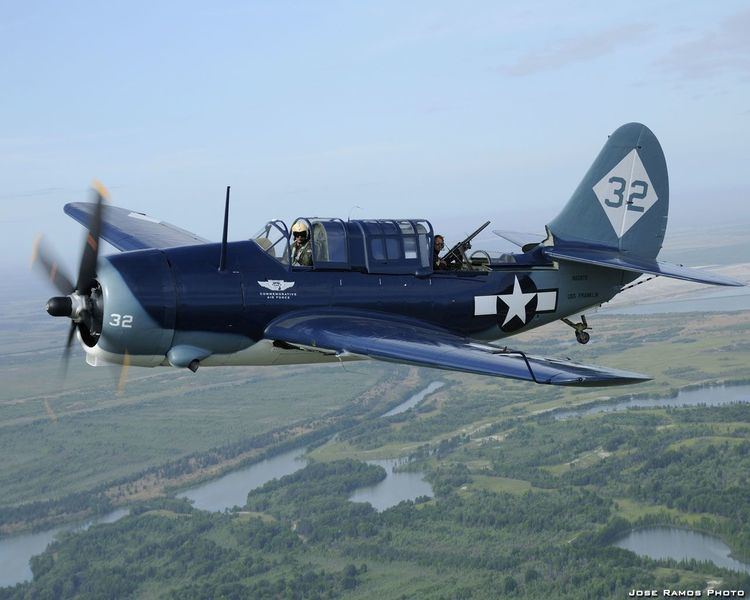
Design and development
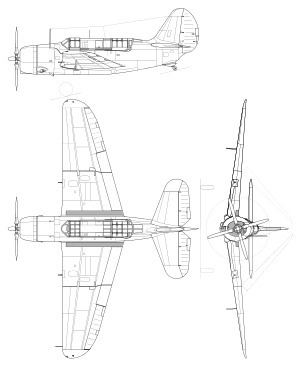
The Helldiver was developed to replace the Douglas SBD Dauntless. It was a much larger aircraft, able to operate from the latest aircraft carriers and carry a considerable array of armament. It featured an internal bomb bay that reduced drag when carrying heavy ordnance. Saddled with demanding requirements set forth by both the U.S. Marines and United States Army Air Forces, the manufacturer incorporated features of a "multi-role" aircraft into the design.
The Model XSB2C-1 prototype initially suffered teething problems connected to its Wright R-2600 Twin Cyclone engine and three-bladed propeller; further concerns included structural weaknesses, poor handling, directional instability and bad stall characteristics. In 1939, a student brought a model of the new Curtiss XSB2C-1 to the MIT wind tunnel. Professor Emeritus of Aeronautical Engineering Otto C. Koppen was quoted as saying, "if they build more than one of these, they are crazy". He was referring to controllability issues with the small vertical tail.
The first prototype made its maiden flight on 18 December 1940. It crashed on 8 February 1941 when its engine failed on approach, but Curtiss was asked to rebuild it. The fuselage was lengthened and a larger tail was fitted, while an autopilot was fitted to help the poor stability. The revised prototype flew again on 20 October 1941, but was destroyed when its wing failed during diving tests on 21 December 1941.
Large-scale production had already been ordered on 29 November 1940, but a large number of modifications were specified for the production model. The size of the fin and rudder was enlarged, fuel capacity was increased, self-sealing fuel tanks were added and the fixed armament was doubled to four 0.50 in (12.7 mm) machine guns in the wings, compared with the prototype's two cowling guns. The SB2C-2 was built with larger fuel tanks, improving its range considerably.
The program suffered so many delays that the Grumman TBF Avenger entered service before the Helldiver, even though the Avenger had begun its development two years later. Nevertheless, production tempo accelerated with production at Columbus, Ohio and two Canadian factories: Fairchild Aircraft Ltd. (Canada), which produced 300 (under the designations XSBF-l, SBF-l, SBF-3 and SBF-4E), and Canadian Car and Foundry, which built 894 (designated SBW-l, SBW-3, SBW-4, SBW-4E and SBW-5), these models being respectively equivalent to their Curtiss-built counterparts. A total of 7,140 SB2Cs were produced in World War II.
U.S. Navy
The U.S. Navy would not accept the SB2C until 880 modifications to the design and the changes on the production line had been made, delaying the Curtiss Helldiver's combat debut until 11 November 1943 with squadron VB-17 on Bunker Hill, when they attacked the Japanese-held port of Rabaul on the island of New Britain, north of Papua New Guinea. The first version of the SB2C-1 was kept stateside for training, its various development problems leading to only 200 being built. The first deployment model was the SB2C-1C. The SB2C-1 could deploy slats mechanically linked with landing gear actuators, that extended from the outer third of the wing leading edge to aid lateral control at low speeds. The early prognosis of the "Beast" was unfavourable; it was strongly disliked by aircrews due to its size, weight, and reduced range compared to the SBD it replaced.
In the Battle of the Philippine Sea, 45 Helldivers were lost because they ran out of fuel returning to their carriers.
Among its major faults, the Helldiver was underpowered, had a shorter range than the SBD, was equipped with an unreliable electrical system, and was often poorly manufactured. The Curtiss-Electric propeller and the complex hydraulic system had frequent maintenance problems. One of the faults remaining with the aircraft through its operational life was poor longitudinal stability, resulting from a fuselage that was too short due to the necessity of fitting on to aircraft carrier elevators. The Helldiver's aileron response was also poor and handling suffered greatly under 90 kn (100 mph; 170 km/h) airspeed; since the speed of approach to land on a carrier was supposed to be 85 kn (98 mph; 157 km/h), this proved problematic. The 880 changes demanded by the Navy and modification of the aircraft to its combat role resulted in a 42% weight increase, explaining much of the problem.
The solution to these problems began with the introduction of the SB2C-3 beginning in 1944, which used the R-2600-20 Twin Cyclone engine with 1,900 hp (1,400 kW) and Curtiss' four-bladed propeller. This substantially solved the chronic lack of power that had plagued the aircraft. The Helldivers would participate in battles over the Marianas, Philippines (partly responsible for sinking the battleship Musashi), Taiwan, Iwo Jima, and Okinawa (in the sinking of the battleship Yamato). They were also used in the 1945 attacks on the Ryuku Islands and the Japanese home island of Honshū in tactical attacks on airfields, communications and shipping. They were also used extensively in patrols during the period between the dropping of the atomic bombs and the official Japanese surrender, and in the immediate pre-occupation period.
An oddity of the SB2Cs with 1942 to 1943-style tricolor camouflage was that the undersides of the outer wing panels carried dark topside camouflage because the undersurfaces were visible from above when the wings were folded.
In operational experience, it was found that the U.S. Navy's Grumman F6F Hellcat and Vought F4U Corsair fighters were able to carry an equally heavy bomb load against ground targets and were vastly more capable of defending themselves against enemy fighters. The Helldiver, however, could still deliver ordnance with more precision against specific targets and its two-seat configuration permitted a second set of eyes. A Helldiver also has a significant advantage in range over a fighter while carrying a bombload, which is extremely important in naval operations.
The advent of air-to-ground rockets ensured that the SB2C was the last purpose-built dive bomber produced. Rockets allowed precision attack against surface naval and land targets, while avoiding the stresses of near-vertical dives and the demanding performance requirements that they placed on dive bombers
The SB2C remained in active postwar service in the US Navy until 1947 and Naval Reserve aviation units until 1950. Surplus aircraft were sold to the naval air forces of France, Italy, Greece, Portugal, and Thailand. Greek SB2Cs served in combat in the Greek Civil War with additional machine guns mounted in wing pods. French SB2Cs flew in the First Indochina War from 1951 to 1954.
Army service
Built at Curtiss' St. Louis plant, 900 aircraft were ordered by the USAAF under the designation A-25A Shrike. The first ten aircraft had folding wings, while the remainder of the production order omitted this unnecessary feature. Many other changes distinguished the A-25A, including larger main wheels, a pneumatic tailwheel, ring and bead gunsight, longer exhaust stubs, and other Army-specified radio equipment. By late 1943, when the A-25A was being introduced, the USAAF no longer had a role for the dive bomber, as fighter aircraft such as the Republic P-47 Thunderbolt had shown their ability to carry out tactical air support missions with great success.
After offering the Shrike to Australia, only ten were accepted before the Royal Australian Air Force rejected the remainder of the order, forcing the USAAF to send 410 to the U.S. Marines. The A-25As were converted to the SB2C-1 standard, but the Marine SB2C-1 variant never saw combat, being used primarily as trainers. The remaining A-25As were similarly employed as trainers and target tugs.
British service
A comparable scenario accompanied the Helldiver's service with the British. A total of 26 aircraft, out of 450 ordered, were delivered to the Royal Navy's Fleet Air Arm, where they were known as the Helldiver I. After unsatisfactory tests that pinpointed "appalling handling", none of the British Helldivers were used in action.
Greek service
American aid provided the Royal Hellenic Air Force with 42 Curtiss SB2C-5 Helldivers from surplus U.S. Navy stocks. In the spring of 1949, the aircraft were given to 336th Fighter Squadron (336 Μοίρα Διώξεως) to replace Supermarine Spitfires and the squadron's name was changed to 336th Bomber Squadron (336 Μοίρα Βομβαρδισμού).
Greek SB2C-5 Helldivers had minor changes for their COIN operations: the hard rubber tailwheel (for carrier use) was replaced by a bigger pneumatic tire for use on landing strips; and the rear gunner station and its twin MGs were deleted, as no aerial opposition existed and weight reduction was used for bombs and extra machine guns.
Curtiss SB2C-5 Helldivers, Supermarine Spitfires and North American T-6D/Gs were used in ground-attack missions against Communist ground forces, camps and transports during the last stages of the Greek Civil War.
Curtiss SB2C-5 Helldivers saw a relatively brief combat service and were gradually phased out by 1953. A few were in use until 1957 as photographic aircraft. One Curtiss SB2C-5 Helldiver was restored in 1997 and is displayed in the Hellenic Air Force Museum.
French service
Between 1949 and 1954, France bought 110 SB2C-5 Helldiver aircraft to replace their aging SBD-5 Dauntless that had been flying in combat in Vietnam. The French Aeronavale flew the Helldiver from 1951 to 1958.
Some of these aircraft were allotted to Escadrille 9F stationed on board the carriers Arromanches, Bois Belleau and La Fayette, during the First Indochina War. The Helldivers were used to support French troops on the ground during the Battle of Dien Bien Phu in 1954.
Variants
Operators
Greece
Thailand
United States
Specifications (SB2C-4 Helldiver)
Data from United States Navy Aircraft since 1911
General characteristics
Performance
Armament
on underwing hardpoints: 500 lb (225 kg) of bombs each
